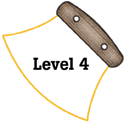
Alaska Science
Key Element A13
 |
Alaska Science |
|
Performance Standard Level 4, Ages 15–18
|
|
|
|
Sample Assessment Ideas
|
|
|
Expanded Sample Assessment Idea
|
|
Procedure Students will:
Reflection and Revision
|
Levels of Performance |
||
|
Stage 4 |
Board game incorporates six or more pieces of information from each content area, and shows extensive evidence of knowledge related to the theory of natural selection, evolution, and change over time. Game includes detailed instructions for how to play. | ||
|
Stage 3
|
Board game incorporates four or more pieces of information from each content area, and shows evidence of knowledge related to the theory of natural selection, evolution, and change over time. Game includes most instructions for how to play. | ||
|
Stage 2
|
Board game uses at least two pieces of information from each content area, but shows limited evidence of knowledge related to the theory of natural selection, evolution, or change over time. Game includes limited instructions for how to play. | ||
|
Stage 1
|
Board game is incomplete, and shows misconceptions or little evidence of understanding of natural selection, evolution, or change over time. | ||
Standards Cross-References
|
||
|
National Science Education Standards Species evolve over time. Evolution is the consequence of the interactions of (1) the potential for a species to increase its numbers, (2) the genetic variability of offspring due to mutation and recombination of genes, (3) a finite supply of the resources required for life, and (4) the ensuing selection by the environment of those offspring better able to survive and leave offspring. [See Unifying Concepts and Processes] (Page 185) The great diversity of organisms is the result of more than 3.5 billion years of evolution that has filled every available niche with life forms. (Page 185) Natural selection and its evolutionary consequences provide a scientific explanation for the fossil record of ancient life forms, as well as for the striking molecular similarities observed among the diverse species of living organisms. (Page 185) The millions of different species of plants, animals, and microorganisms that live on Earth today are related by descent from common ancestors. (Page 185) Biological classifications are based on how organisms are related. Organisms are classified into a hierarchy of groups and subgroups based on similarities which reflect their evolutionary relationships. Species is the most fundamental unit of classification. (Page 185) |
Benchmarks The basic idea of biological evolution is that the Earth’s present-day species developed from earlier, distinctly different species. (Page 125) Molecular evidence substantiates the anatomical evidence for evolution and provides additional detail about the sequence in which various lines of descent branched off from one another. (Page 125) Natural selection provides the following mechanism for evolution: Some variation in heritable characteristics exists within every species, some of these characteristics give individuals an advantage over others in surviving and reproducing, and the advantaged offspring, in turn, are more likely than others to survive and reproduce. The proportion of individuals that have advantageous characteristics will increase. (Page. 125) Heritable characteristics can be observed at molecular and whole-organism levels-in structure, chemistry, or behavior. These characteristics strongly influence what capabilities an organism will have and how it will react, and therefore influence how likely it is to survive and reproduce. (Page 125) New heritable characteristics can result from new combinations of existing genes or from mutations of genes in reproductive cells. Changes in other cells of an organism can not be passed on to the next generation. (Page 125) Natural selection leads to organisms that are well suited for survival in particular environments. Changes alone can result in the persistence of some heritable characteristics having no survival or reproductive advantage or disadvantage for the organism. When an environment changes, the survival value of some inherited characteristics may change. (Page 125) The theory of natural selection provides a scientific explanation for the history of life on Earth as depicted in the fossil record and in the similarities evident within the diversity of existing organisms. (Page 125) Life on Earth is thought to have begun as simple, one-celled organisms about 4 billion years ago. During the first 2 billion years, only single-cell microorganisms existed, but once cells with nuclei developed about a billion years ago, increasingly complex multi-cellular organisms evolved. (Page 125) Evolution builds on what already exists, so the more variety there is, the more there can be in the future. But evolution does not necessitate long-term progress in some set direction. Evolutionary changes appear to be like the growth of a bush: some branches survive from the beginning with little or no change, many die out altogether, and others branch repeatedly, sometimes giving rise to more complex organisms. (Page 125) |
|
Table of Contents | Return to Alaska Native Knowledge Network